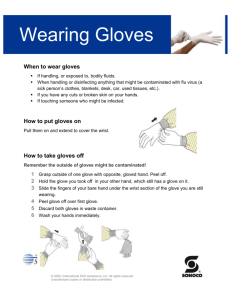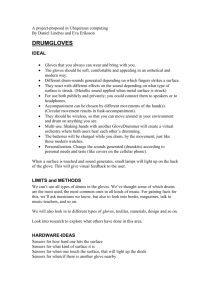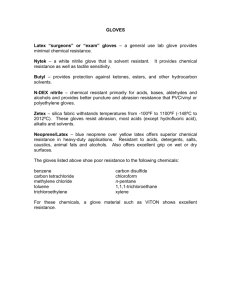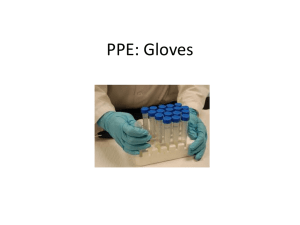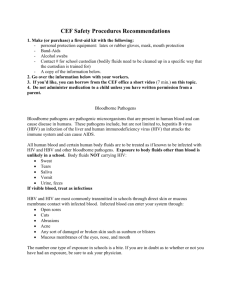INFECTION CONTROL UNIVERSAL PRECATIONS
advertisement
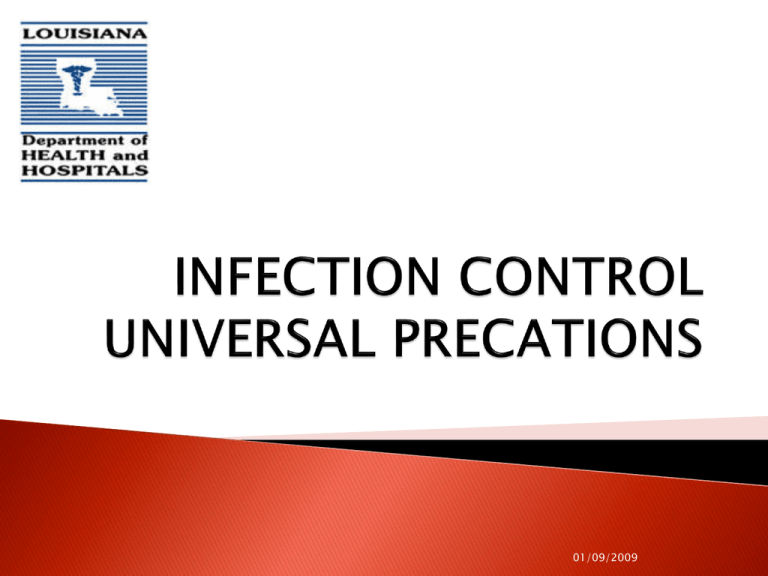
01/09/2009 At the end of this session, the participants will be able to: ◦ Verbalize definitions related to infection control ◦ List modes of transmission of infections and portals of entry of bacteria ◦ Explain universal precautions ◦ Explain the worker’s role in preventing spread of infections ◦ Demonstrate proper hand washing techniques, application and removal of gloves ◦ Describe appropriate techniques for cleaning up spills 01/09/2009 Infection control – the set of methods used to control and prevent the spread of disease Infections - are caused by pathogens (germs) Communicable disease – disease spread from one person to another Infectious disease – disease caused by a pathogen (germ or bacteria) 01/09/2009 Contaminated – means dirty, soiled, unclean Disinfection – cleaning so that germs (pathogens) are destroyed Mode of transmission – the way germs are passed from one person to another Mucous membranes – membranes that line body cavities that open to the outside of the body 01/09/2009 Body fluids – tears, saliva, sputum (mucus coughed up), urine, feces, semen, vaginal secretions, pus or other wound drainage, blood Touching the infected person or their secretions Touching something contaminated by the infected person. Droplets – coughing, sneezing, laughing, spitting, talking 01/09/2009 Any body opening of an uninfected person which allows pathogens to enter Nose, mouth, eyes, rectum, genitals and other mucous membranes Cuts, abrasions or breaks in the skin 01/09/2009 Anyone whose resistance to disease decreases Reasons for lowered resistance: age, existing illnesses, fatigue and stress The elderly have weaker immune systems and a lower resistance to pathogens Elderly are hospitalized more often, increasing the chance for hospital-acquired infections Recovery longer in the elderly 01/09/2009 Universal precautions are infection control guidelines designed to protect workers from exposure to diseases spread by blood and certain body fluids. Always treat blood, body fluids, broken skin and mucous membranes as if they were infected Always follow Universal Precautions because you cannot tell by looking at a person whether they have a contagious disease 01/09/2009 Use practical, common sense Wash your hands before putting on gloves and immediately after removing gloves Do not touch clean objects with contaminated gloves 01/09/2009 Wear gloves if you may come in contact with blood, body fluids, secretions and excretions, broken or open skin, human tissue of mucous membranes Bag all disposable contaminated supplies Clean all surfaces that may be contaminated with infectious waste, such as beds, wheelchairs and shower chairs 01/09/2009 Good hand washing is the most effective method to prevent the spread of infection May use an alcohol-based hand cleaner in place of washing with soap and water Avoid touching eyes, nose or mouth 01/09/2009 Cover your nose and mouth with a tissue every time you cough or sneeze Throw used tissue in a wastebasket If you don’t have a tissue, sneeze or cough into your sleeve Always clean your hands after coughing or sneezing 01/09/2009 Remove any jewelry or watch Wet hands with warm, running water Add soap Rub hands vigorously for 20 seconds, washing all surfaces (about the time it takes to sing “Happy Birthday” twice) Rinse, keeping fingers pointing down Dry with paper or clean cloth towel Turn off faucet with towel and open door with towel 01/09/2009 Make sure all visible dirt is removed from your hands Apply a dime sized amount of waterless hand sanitizer to the palm of one hand or use a waterless hand sanitizer wipe Rub hands together covering all surfaces of hands and fingers Rub until waterless hand sanitizer is absorbed Remember, waterless sanitizers are not effective if dirt is visible on your hands 01/09/2009 View these videos on hand hygiene: http://www.cdc.gov/CDCTV/HandsTogether/ Play entire video: http://www.publichealthgreybruce.on.ca/Com municable/Handwashing/ Application of learning – student return demonstration 01/09/2009 When you may come in contact with blood or any body fluids, open wounds, or mucous membranes Performing or helping with mouth care Performing or helping with perineal care Performing care on a consumer who has broken skin 01/09/2009 When you have open sores or cuts on your hands When shaving a consumer When disposing of soiled bed linens, gowns, dressings and pads 01/09/2009 When touching surfaces that may be contaminated Right before contact with mucous membranes or broken skin Immediately if they become wet, worn, soiled or torn 01/09/2009 Wear gloves when handling soiled linens Fold or roll linen so that the dirtiest area is inside Hold and carry dirty linen away from your body Do not shake dirty linen or clothes 01/09/2009 Use appropriate receptacles for disposal Do not touch the inside of any disposal container Do not use “re-usable” equipment again until it has been properly cleaned Never use disposable equipment more times than recommended by the manufacturer 01/09/2009 1. Remove any sharp jewelry 2. Remove glove from box. Gloves come in small, medium and large. Most are rubber latex and are pre-powdered. Those who are allergic to latex should use vinyl gloves. 3. Hold glove with your thumb and forefinger and insert hand into gloves 4. Work fingers into proper places 01/09/2009 http://www.uams.edu/csc/programs/orientat ion/gloves/glovesOn.mov Application of learning – student return demonstration 01/09/2009 1. Pinch the palm of one glove and pull away from the palm. 2. Push the fingers of the pinching hand up inside the other glove, stretching the material of the glove towards the cuff of the other glove until it emerges by the wrist. 3. Pull the fold down until the glove is almost off (you will be pulling the glove inside-out). 01/09/2009 4. DO NOT take the glove completely off. 5. Hook the ungloved thumb between the wrist and the skin of the other gloved hand and pull down, pulling both gloves off. (Both gloves will now be inside out.) 6. Dispose of the gloves properly. 01/09/2009 Click for video instruction for removing contaminated gloves: http://www.hse.gov.uk/mvr/myths/video/vid eo9.htm Application of learning – student return demonstration 01/09/2009 Put on clean gloves Wipe up immediately by cleaning from the outside (cleanest) to the inside (dirtiest) Use the appropriate cleaning agent Never pick up glass, even with gloved hands Dispose of gloves and cleaning equipment and supplies 01/09/2009 01/09/2009
